 This is the next part of Crimson Peak movie costumes analysis. In this material, we’ll talk about Edith Cushing’s outfits in all their glory. Unlike the costumes of Lucille Sharpe with her femme fatale look, Edith’s dresses radiate youth, innocence, and naivety. The costume designer of this film Kate Hawley even compares Edith with a canary in a coal mine. But all this doesn’t make her clothing pieces any less interesting and attractive. Let’s take a look at these costumes and some of their real-life historical equivalents.
This is the next part of Crimson Peak movie costumes analysis. In this material, we’ll talk about Edith Cushing’s outfits in all their glory. Unlike the costumes of Lucille Sharpe with her femme fatale look, Edith’s dresses radiate youth, innocence, and naivety. The costume designer of this film Kate Hawley even compares Edith with a canary in a coal mine. But all this doesn’t make her clothing pieces any less interesting and attractive. Let’s take a look at these costumes and some of their real-life historical equivalents.
This article is based on the video from a YouTube channel “Costume CO”.
Read also: Crimson Peak stage costumes and their real-life historical equivalents. Lucille Sharpe
In our first glimpse of Edith, we see her wearing this gold walking outfit. Kate Hawley explains that Edith's gold palette also shows her to be a canary in a coal mine – her character’s warning of the coming danger. Edith’s color palette also shows the American heiress’s wealth.
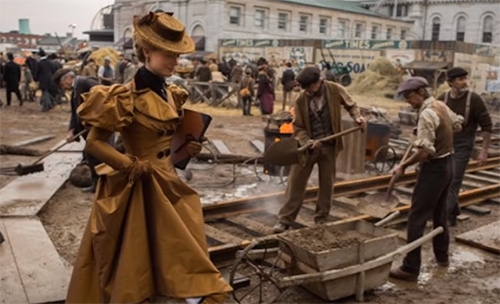
Here are two examples of the late 1880s lady’s walking suits with a similar silhouette. The afternoon ensemble on the left in the same golden tones that Edith's walking suit consists of a bodice and skirt by American designer HS Poco, it’s from 1896-1897. It is constructed with silk sequins and metallic thread. While the suit on the right is from 1895, it was made by Parisian designer Jacques Doucet. This suit is linen, with the collar and cuffs embroidered with silk cord, elastic stays are attached to the inside of the skirt to control the fullness.

The exaggerated puff sleeves on Edith's jacket resemble the wings of a butterfly – a symbol for Edith, as Hawley explains it. On the right, is a close-up of the skull pin used to fasten her tie.
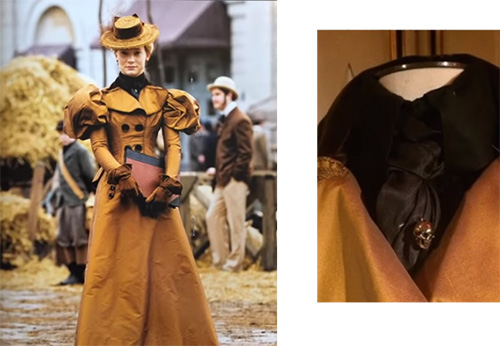
According to Kate Hawley, the puff sleeves on Edith's costumes are enormous but not much bigger than that which is historically accurate. She says, “We actually had a very beautiful piece given to us. They had an original 1890s, late 1890s gown with a bodice, and we actually analyzed the sleeve action going on. It was 3.5 meters of fabric per sleeve. So the dresses we did for Mia [Mia Wasikowska, actor who played Edith Cushing] were the same just on the sleeve alone. They are quite structural and complex. That original gown came for an old couture house in Paris”.
This American tailored jacket from 1895 is a close approximation to Edith's. Like Edith's jacket, it is double-breasted with an oversized buttons and leg’o’mutton sleeves. This outfit is the Victorian equivalent of a sporting outfit, in this case, used for cycling.

The hat Edith wears is a lady’s sailor hat with birdcage netting and it's trimmed with a golden-brown silk velvet ribbon.

A sailor hat like the one, seen here by the two women in the back row from the early 1900s photograph, is a brimmed straw hat similar to those historically worn by 19th-century sailors before the sailor cap became standard. It is very close in appearance to the masculine straw boater seen on the man sitting down. It's normally made of stiff straw and has a stiff flat crown and brim.
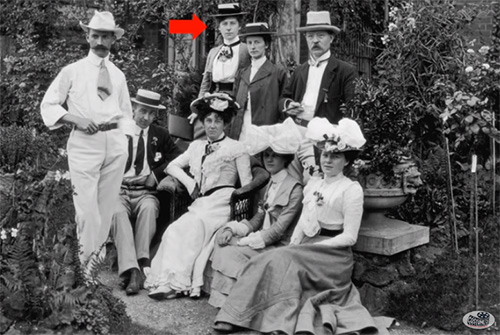
Here are two samples of lady’s sailor hats from the period from the Metropolitan Museum of Art. The straw boater on the right is straw, with a silk band, and dates 1890-1900.
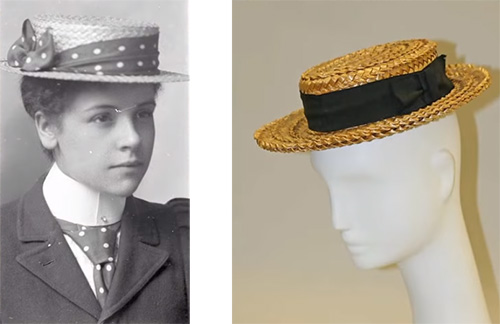
This is Edith’s outfit when she first encounters Thomas. The blouse is pleated with the treebark technique, a type of wrinkled pleating.
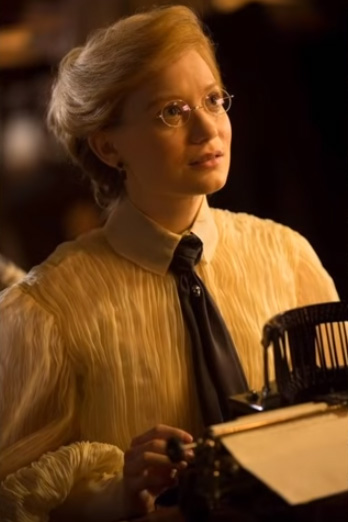
The treebark pleating is similar to broomstick pleating, a type of hand-pleating. Before the advent of commercial pleating, all pleating was done by hand, dating back to the Egyptians and the Greeks.

The wrinkle pleating or antique pleating has irregular ridges and grooves, set by bunching and scrunching damp fabric, securing it tightly, and letting it dry. The process is less than ideal for because the process only works on natural fibers like cotton or silk, and the process is not permanent.
When unwrapped, the wrinkled folds in muslin, as seen on the left with broomstick pleating, are one-directional, while the wrinkled folds seen on the right with contortion pleating are multi-directional. This process is temporary, however, because washing will remove the pleats.
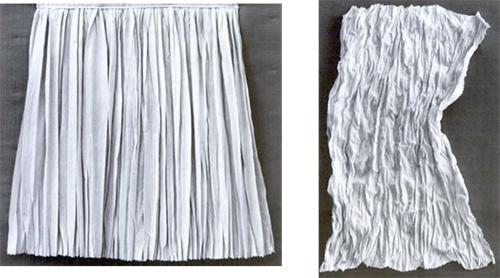
Pleating became a fashionable fabric manipulation during the early 20th century. On the left, is a beautifully hand-pleated silk jersey gown from 1937 by Madame Gres. She became famous for elegantly draped Grecian goddess gowns. These dresses could take anywhere up to 300 hours to complete, with each pleat being done by hand, draping the cloth so the body shaped the dress. Also reviving the Grecian silhouette in the early 1900s was Spanish-born artist and designer Mariano Fortuny. He established a textile workshop and a commercial silk printing fabric in Italy, where he perfected fine, heat-set pleating in silk, which was created by a process never exactly duplicated. Pictured on the right, is a portrait of Miss Muriel Gore in a Fortuny dress from 1919, painted by Sir Oswald Hornby Joseph Birley.

What's astounding is that the Fortuny gowns on exhibit in museums still hold their pleating to this day.
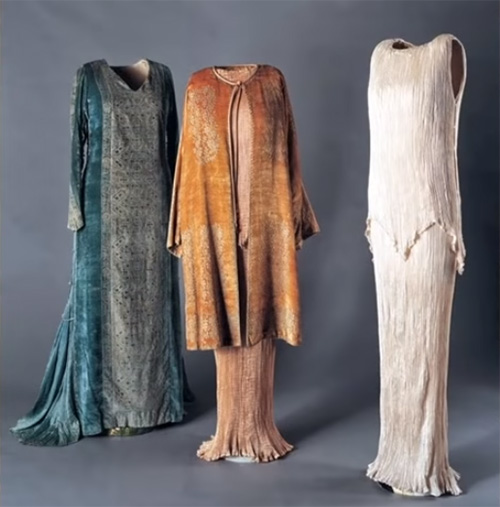
Edith attends a ball with Thomas in this sophisticated, yet understated silk gown with a train and a style similar to the fashions of high-society women in turn-of-the-century America. The long bodice is softly draped in silk and decorated with strands of pearls. There is no crinoline, except for what looks like a soft tulle petticoat peeking out from under the train. This light-cream color was fashionable for even married women.

The gown features a matching cloak with an outstanding pleated stand-up collar. The cloak is pleated into a yoke neckline and fastened at the neck.
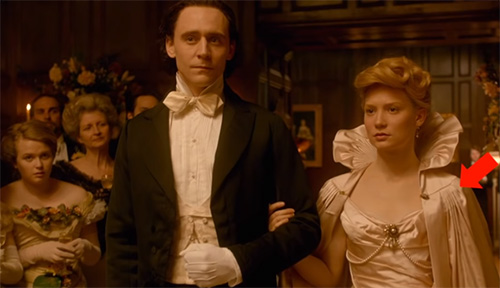
Here are some samples of this style in various portraits of high society women from the late 1800s and early 1900s by Italian painter Giovanni Boldini. It is a portrait of American socialite and author Elizabeth Wharton Drexel from 1905 on the left. We can't determine who painted the portrait of the lady on the right, but it looks like it's from the late 1800s.

Here are three other paintings by Boldini. Essential painting is a Portrait of Ava Lister, Baroness Ribblesdale, while the painting on the right is a Portrait of the Countess Zichy – both from 1905.

On the left, is a fabulous painting that features the fashionable Gibson-girl hairstyle of the day. The hairstyle was made famous by illustrator Charles Dana Gibson and actresses of the day, like Emile Clifford. The pompadour-style hairstyle was also highly coveted by the most fashionable of society ladies. You can see that Edith's hair has been swept up in a similar fashion and embellished by a beautiful rhinestone hairpin.

Here is Edith's picnic dress.
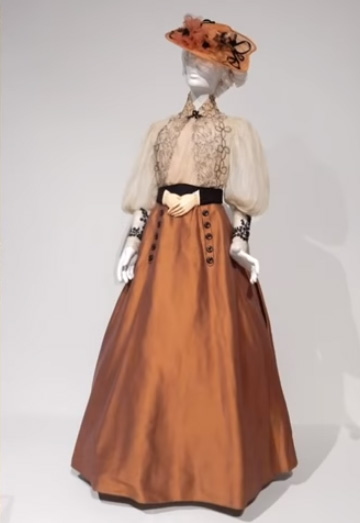
On the left, you see that Kate Hawley and her team played with the fabric on the dressmaker’s form before actually constructing it. Of Edith's memorable belt, the designer says, “People plaited the hair and braids of their loved ones that had passed away and there were little ivory earrings and things. I took these little earrings, these little ivory hands, and we scaled them up so it was almost like a mother's hands clasped around her waist”.
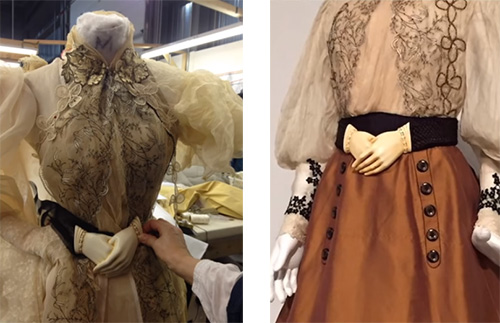
Here is Kate Hawley's idea board for Victorian mourning jewelry made from human hair. You can see that this gold bracelet in the center with hands clasped was Hawley's inspiration for Edith's belt.

While hair from deceased loved ones was frequently used in mourning pieces, more often, the hair of the living was worked into sentimental keepsakes given as everlasting tokens of friendship, remembrance, or romantic love.
On the left, is a gold and enamel mourning ring with hair of the deceased under glass from circa 1855. On the right, is a Victorian watch chain of human hair with gold clasped hand detail, similar to the one from Hawley's idea board.
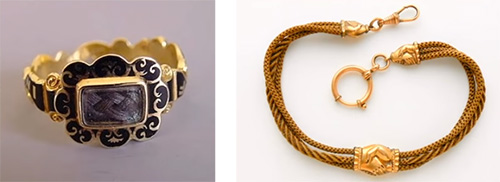
The hands were sculpted in wax and then cast to look like ivory, like the image on the left.
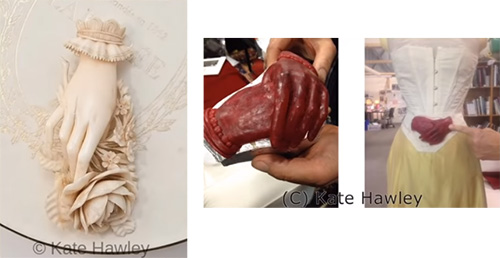
Here is the final belt on exhibit.
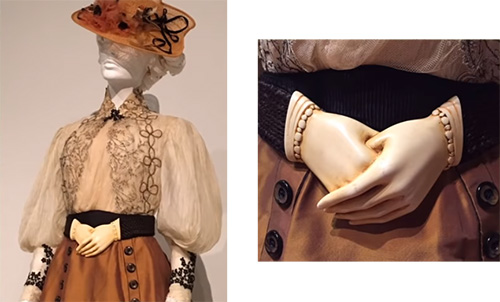
This is Kate Hawley's mood board for Edith's picnic dress.
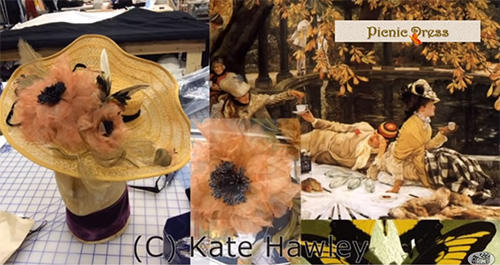
Edith’s dresses and nightgowns are adorned with flowers, meaning “fertility”. Kate Hawley says, “The silhouette of the sleeves becomes fuller and the flowers start growing on her dress. I look at it like the Magic Flute and its Sun and Moon, night and day, winter and summer – polar opposites”.

Here is a close-up of Edith's hat adorned with silk poppies and feathers and ribbons and ribbon trim shaped like butterflies.

On the left, we have a French hat from 1902 made of cotton and silk that is very similar to Edith's. And on the right, we have a French hat circa 1898 made from silk metal rhinestones. Both of these hats are from an exhibit at The Met.
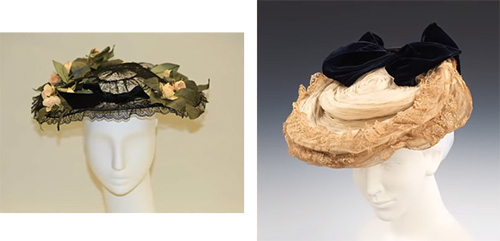
Pictured on the right, are Edith's boots from Crimson Peak, an almost exact reproduction of the Victorian boots on the left that come from 1870.

This dress is another great attire for Edith, and it's known by Kate Hawley as the “heartbreak dress”. It’s made from multiple layers of dyed and pleated silk fabric. The gown might have got its name because Edith discovers that her beloved father has died while she is wearing it. The collar and cuffs are trimmed in some sort of applique and embroidery technique. It looks similar to soutache trim, only finer. The decoration serves two purposes – it holds the narrow pleats in place and it creates a beautiful focal point to the neck.
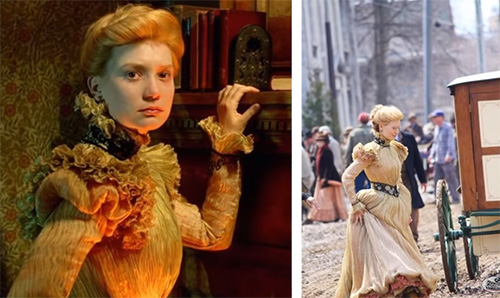
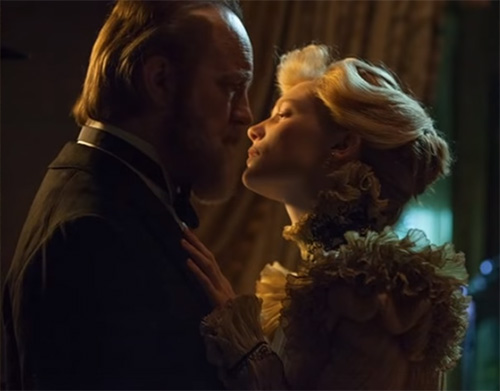
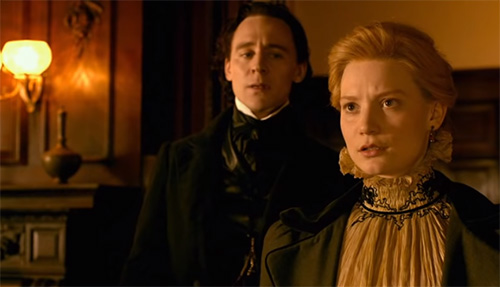
Sadly, we get to see very little of this gorgeous mourning outfit. It's difficult to tell but it looks like she's wearing a black velvet coat with large puff sleeves and a wide-brimmed felt hat with large black ostrich plumes that are anchored with a jet beaded broach. Edith's face is covered with a black netting that's trimmed with fine cord.

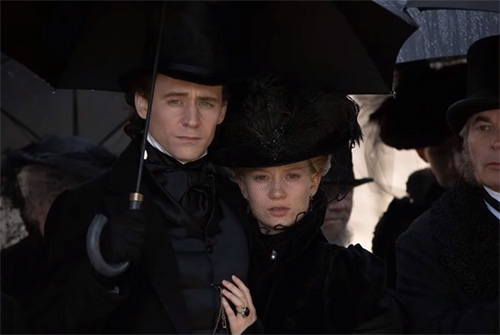
Of Edith's wedding cloak and hat, Kate Hawley says, “With things like flowers and fruits, we had violets when she arrives at Allerdale Hall to enhance the symbolism of this luscious living thing in contrast to the Baroness of Allerdale. The collar of the cloak and capelette are also decorated with black soutache cord.

We see that the cloak and hats are embellished with violets pictured on a worktable in the Crimson Peak wardrobe. The violets are sorted by color before being tacked on to the costume.
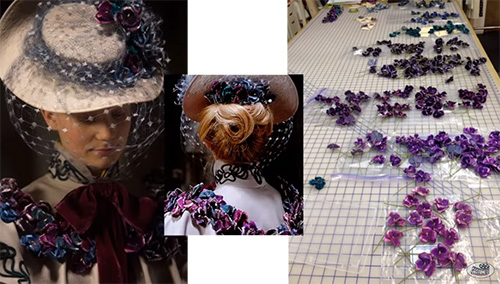
But Kate Hawley adds, “When Edith travels to England with the Sharpe's, the glasses come off. You see the decay and the reality of their world and how unromantic it is”.
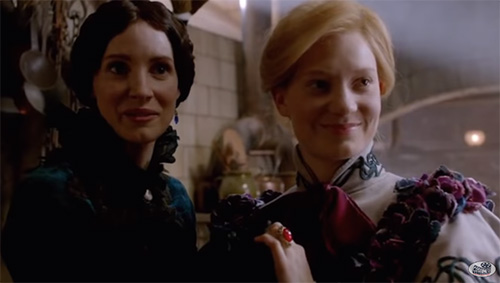
All of the silk violets are stripped from the cloak, even the pretty violet sash, replaced with a more somber teal one, in keeping with the blue tones of Allerdale Hall.

In a moment of vulnerability, when Edith arrives at Allerdale Hall, we get a rare glimpse at Edith's underset things, including her corset and petticoat.
She wears a French shawl jacket of sorts as she runs her bath. The robe appears to be woven silk and it's trimmed in wide crochet and fringe border. There is a single button fastener at the front.

The robe is similar to the styles of cloaks fashioned from large shawls that were popular with the late Victorian period from until the 1920s. On the left, from a private collection, is a Chinese silk cape from the 1880s. The cape is made from embroidered cream silk, featuring a fitted back with a large knotted and tasseled medallion, and it's edged with knotted French silk. On the right, is a similar hand-embroidered silk cloak from about 1890-1900. The cape is also bordered all around with hand-knotted silk fringe.
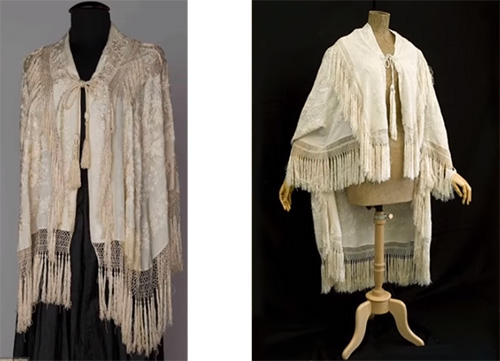
Of the undergarments like corsets and petticoats, Kate Hawley states that “All of these items had to be handcrafted from scratch. Things like the types of corsets we chose, the underpinnings which would define the outer structure, they are all true to the period”.
Luckily for us, we get a little bit of a glimpse of Edith’s chemise and corset. The corset is golden silk satin and, in keeping with her other costumes, the chemise worn under the corset is finely pleated lightweight silk.
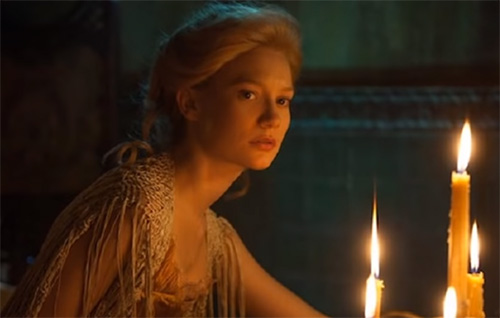

Edith might have worn a one-piece slip, like the one pictured on the left, circa 1900s from the United States, Museum of Fine Arts in Boston. It's more likely that she wore a separate camisole and petticoat. On the right, is a painting by Pierre Carriere-Belleuse from 1893, titled “Young Woman Adjusting Her Corset”. The painting is a little early and the corset is a little high in the hips, but the silhouette is similar to Edith's undergarments.

Here is a period-correct corset from 1903 from a French fashion plate.
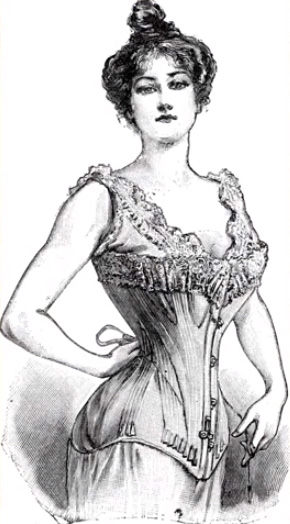
Here is an example of a French trousseau corset from 1900, still in excellent condition, by Le Bon Marché in Paris. The corset is made from embroidered silk satin, ribbon, and lace.
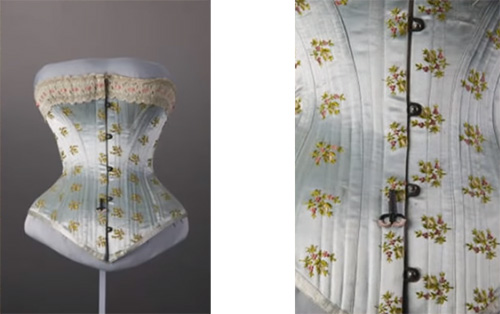
“If you look at her nightdress”, Kate Hawley says, “we made many, many nightdresses. Sometimes the sleeves are big, sometimes the sleeves are small. We'd have to sit Mia in the chair and we'd work at the right size of sleeves to make her seem really small. It's all about running around in nightdresses through long corridors that also blended the fabric”.

Edith’s heavily pleated white nightgown is symbolic of a chrysalis as Edith begins to fade. Kate Hawley says, “She's very fragile, so the butterfly is dying and becoming this little husk. Guillermo [Guillermo del Toro, film director] himself told me to add another 20% on because things always get reduced”.
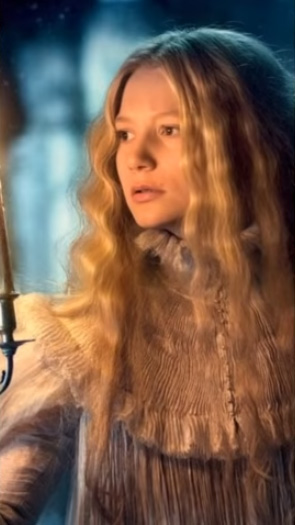
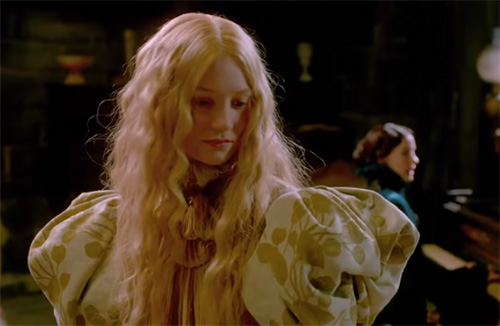
There was a lot of costume experimentation and prototyping that went on. Kate asked herself, “When does a sleeve get too big? I've never done as many nighties as I've done on this film. The team would ask, ‘can we get another nightdress?’ and I’d be thinking, how many ways can I do a nightdress. I feel like I've done my nightdress quota for a while”.
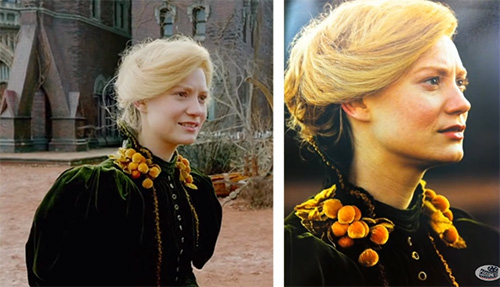
Dressing gowns or tea gowns were originally designed in the 1870s as easy, comfortable garments appropriate for women to wear for tea with family and friends in the home, but they became increasingly elaborate and fitted. By the 1890s, they combined exotic fabrics and historical references and were worn for public appearances, such as dinner parties.
Here are two examples of dressing gowns from the period, both from the House of Worth. On the left and on display at The Met, is a silk and cotton tea gown from 1898. The sleeves and collar of this tea gown reference the early 17th century, which was a common period for Worth to draw from. And on the right, is a Worth tea gown from 1894 from the Museum of the City of New York.

Here is another example of an elaborate tea gown from 1900. The lace wrapper is made from generous amounts of Irish Limerick lace.

The loose box pleats, which are a feature of this style of dressing gown, are sometimes called “Watteau pleats” from their appearance in the paintings of Antoine Watteau, which feature early examples of the 18th-century sack back gowns. The various Watteau terms such as Watteau pleats, Watteau back, and Watteau gown normally describe 19th- and 20th-century revivals of the sack back gowns.
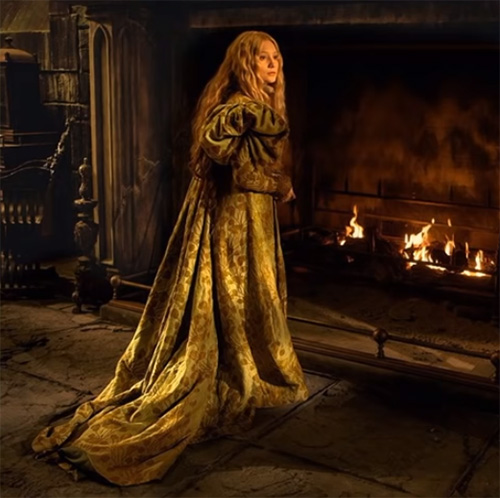
Here are two paintings by Jean Antoine Watteau. On the left, “The Halt during the Chase” circa 1718-1720. And on the right, “Two Cousins” from 1716. Both are featuring Watteau pleats.

And another Edith’s dress – her yellow silk gown.
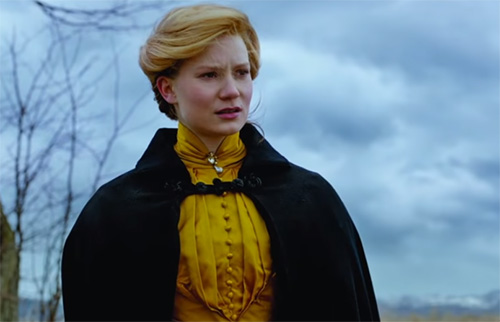
Kate Hawley’s mood board shows her historical and contemporary inspiration for the color and drape of the gown.

The color of this gown is somewhere between a canary yellow and a mustard yellow. The designer says, “We did lots of camera tests for that color, too, because it's quite a tricky color”.
It definitely paid off because the gown looked amazing in both interior and exterior shots.
On the left, the gown looks almost mustard, while on the right, in an image that looks like a painting, the gown luminesces in the lighting – the beautiful appliquéd flowers are featured prominently on the oversized sleeves.

During the initial construction phase, you can see that Kate Hawley has attached color photocopies of the flowers to the lower sleeves and bodice before finalizing their eventual placement. And on the right, the flower appliques are added to what will be the bodice waistband.
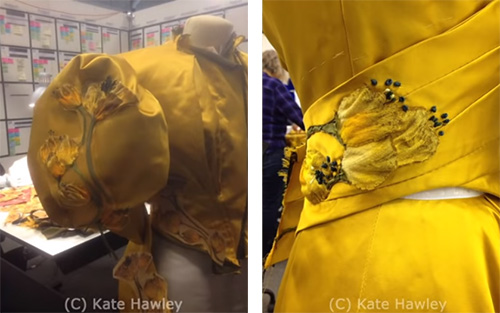
Here is just one example of the labor-intensive handiwork by one of Hawley's team of stitchers in applying the flowers to the silk on the skirt train. On the right, with the flowers tacked to the sleeves, final touches are added to the gown, including the black taffeta sash placement, to the collar, and buttons to the sleeves.
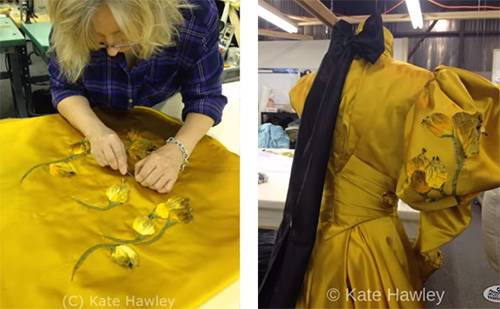
In this close-up, you can see just how lustrous the fabric is and how the details just pop.

Here is the final gown on display.
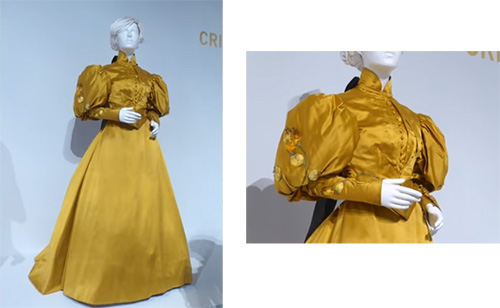
(c)


